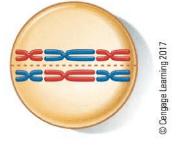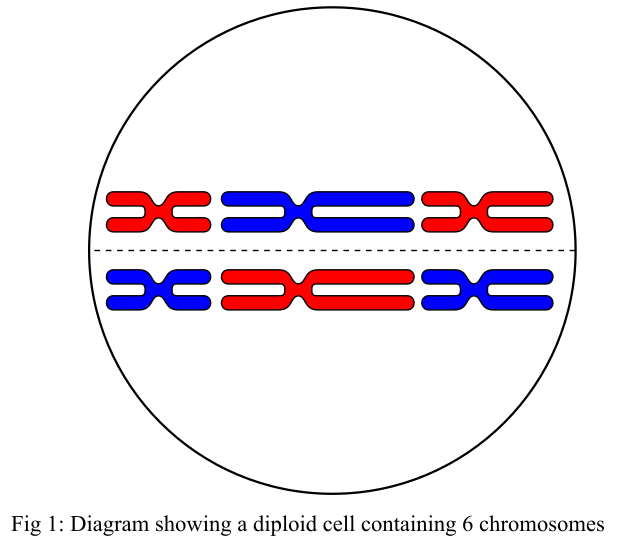
Concept explainers
The chromosome constitution number of this individual is

This drawing represents:
a. mitotic metaphase.
b. meiotic metaphase I.
c. meiotic metaphase II.
d. a gamete.
e. sixnonhomologous chromosomes.
Introduction:
The cell cycle consists of two main divisions known as mitosis and meiosis. Mitosis is the first division during the cell cycle in which the number of chromosomes remains same as the number of chromosomes in the parent cell; on the contrary, in meiosis, the number of chromosomes gets reduced to half.
Answer to Problem 1TYK
Correct answer:
Metaphase 1 of meiosis.
Explanation of Solution
Justification for the correct answer:

Option (b) is meiotic metaphase 1. There are two meiotic divisions after mitosis, namely, meiosis 1 and meiosis 2. During the meiosis 1, the paired chromosomes, also known as bivalent, arrange themselves on the metaphase plate. These paired chromosomes align at the middle of the plate and get attached to the meiotic spindle. The spindle is formed from the structure of the protein, which is responsible for dividing the genetic material in the cell. Hence, option (b) is correct.
Explanation for the incorrect answer:
Option (a) is metaphase in mitosis. Mitosis is the first part of the cell cycle that takes place before the meiosis. Metaphase stage in mitosis involves the arrangement of most condensed chromosomes and these chromosomes then get coiled at this stage. During the metaphase stage of meiosis, the chromosomes are not paired. So, it is an incorrect option.
Option (c) is metaphase 2 phase of meiosis 2. The chromosomes in the meiosis 2 are similar to the chromosomes found in the metaphase stage of mitosis. During the meiosis 2, the chromosomes get condensed and attach themselves to the spindles arising from the centromere present at the opposite poles. These condensed chromosomes are aligned on a metaphase plate but they are in a condensed form. So, it is an incorrect option.
Option (d) is a gamete. During fertilization fusion of one haploid gamete with another haploid gamete results in the formation of a diploid zygote. Number of chromosomes in a haploid cell is 23, two haploid cells fuse together to form a diploid cell. During meiosis number of chromosomes are reduced to 23 from 46 chromosomes. So, it is an incorrect option.
Option (e) states that number of non-homologous chromosomes is 6. Paired chromosomes are the one in which one chromosome is a homolog to another chromosome. These paired chromosomes have the same gene content and possess the same morphology as well. Non-homologous chromosomes are paired chromosomes in which both the chromosomes possess a different gene content. So, it is an incorrect option.
Hence, options (a), (c), (d), and (e) are incorrect.
Therefore, it may be concluded that in the metaphase division of meiosis 1 alignment of paired chromosomes on the metaphase plate takes place. These paired chromosomes get attached to the spindle fibers during this (metaphase 1) stage.
Want to see more full solutions like this?
Chapter 11 Solutions
Biology: The Dynamic Science (MindTap Course List)
- If a diploid organism has 14 chromosomes (2n=14) a. How many chromosomes will its gametes have? b. After meiosis I during gamete formation, how many chromosomes are in each daughter cell? c. After meiosis I during gamete formation, how many chromatids are in each daughter cell?arrow_forwardWhich of the following meiotic events by itself does NOT result in an abnormal set of genes in a gamete? a. Translocation b. Deletion c. Nondisjunction d. Recombination e. Inversionarrow_forwardA cell in G1 of interphase has 12 chromosomes (2 n = 12). How many chromosomes and DNA molecules will be found per cell when this original cell progresses to the following stages? a. G2 of interphase b. Metaphase I of meiosis c. Prophase of mitosis d. Anaphase I of meiosis e. Anaphase II of meiosis f. Prophase II of meiosis g. After cytokinesis following mitosis h. After cytokinesis following meiosis IIarrow_forward
- Separation of homologous chromosomes during Meiosis I requires: Select one: a. Removing centromere cohesion b. Nondisjunction c. Separase If nondisjunction occurred during Meiosis II: Select one: a. We assume all other meiotic events occurred normally b. All four gametes will be abnormal c. There is a higher risk that a second nondisjunction event occurredarrow_forwardShown below is a photomicrograph of Rhoeo tradescantia cell undergoing meiosis. Answer the following question for the photomicrograph: a. Identify the cytogenetic abnormality observed (ex. ring, chain, laggard, bridge) b. Identify the meiotic stage in which these aberrations are observed (as shown in the photomicrograph) c. Explain how these aberrations are formed d. Will this result to sterile or fertile gametes? Explain.arrow_forwardIn what phase of meiosis/mitosis would you find doubled chromosomes moving to opposite sides of a cell? Group of answer choices A. metaphase of meiosis 1 B. anaphase of mitosis C. anaphase of meiosis 2 D. anaphase of meiosis 1 E. metaphase of meiosis 2arrow_forward
- 2) A. Explain how polyribosomes form. B. Why might you expect the insertion of 3 DNA base pairs to be less disruptive than th deletion of a single base pair? C. Compare and contrast mitosis and meiosis with respect to their genetic outcomes? D. What are the possible consequences of non-disjunction during cell division? E. How does meiosis increase genetic diversity in populations?arrow_forwardDown's syndrome, trisomy 21, is due to what likely problem during meiosis? Select one: a. Failure of the APC to add Ub to cohesins, so sister chromatids due not split correctly in anaphase II. b. DNA replication issues causing an additional third chromosome to be replicated. c. Overactive APC adding to many Ub to cohesins, so sister chromatids due not split correctly in anaphase II. d. Failure of the MPF to add Ub to cohesins, so sister chromatids due not split correctly in anaphase II.arrow_forwardShown below are photomicrographs of Rhoeo tradescantia cells undergoing meiosis. Answer the following question for each of the photomicrograph: a. Identify the cytogenetic abnormality observed (ex. ring, chain, laggard, bridge) b. Identify the meiotic stage in which these aberrations are observed (as shown in the photomicrograph) c. Explain how these aberrations are formed d. Will this result to sterile or fertile gametes? Explain.arrow_forward
- An organism has a diploid number of 20 in a primary oocyte. a. How many tetrads are present in the meiotic prophase l? b. How many dyads are present in the meiotic prophase II ? c. How many monads migrate to each pole during meiotic anaphase II ?arrow_forwardWhat is the significant events of the stages in Meiosis? (explain in 2-3 sentences)a. Prophase Ib. Metaphase Ic. Anaphase Id. Telophase Ie. Prophase IIf. Metaphase IIg. Anaphase IIh. Telophase IIarrow_forwardAn individual heterozygous for a reciprocal translocation possesses the following chromosomes: A B • C D E F G A B • C D V W X R S • T U E F G R S • T U V W X a. Draw the pairing arrangement of these chromosomes in prophase I of meiosis. b. Diagram the alternate, adjacent-1, and adjacent-2 segregation patterns in anaphase I of meiosis. c. Give the products that result from alternate, adjacent-1, and adjacent-2 segregation.arrow_forward
 Human Anatomy & Physiology (11th Edition)BiologyISBN:9780134580999Author:Elaine N. Marieb, Katja N. HoehnPublisher:PEARSON
Human Anatomy & Physiology (11th Edition)BiologyISBN:9780134580999Author:Elaine N. Marieb, Katja N. HoehnPublisher:PEARSON Biology 2eBiologyISBN:9781947172517Author:Matthew Douglas, Jung Choi, Mary Ann ClarkPublisher:OpenStax
Biology 2eBiologyISBN:9781947172517Author:Matthew Douglas, Jung Choi, Mary Ann ClarkPublisher:OpenStax Anatomy & PhysiologyBiologyISBN:9781259398629Author:McKinley, Michael P., O'loughlin, Valerie Dean, Bidle, Theresa StouterPublisher:Mcgraw Hill Education,
Anatomy & PhysiologyBiologyISBN:9781259398629Author:McKinley, Michael P., O'loughlin, Valerie Dean, Bidle, Theresa StouterPublisher:Mcgraw Hill Education, Molecular Biology of the Cell (Sixth Edition)BiologyISBN:9780815344322Author:Bruce Alberts, Alexander D. Johnson, Julian Lewis, David Morgan, Martin Raff, Keith Roberts, Peter WalterPublisher:W. W. Norton & Company
Molecular Biology of the Cell (Sixth Edition)BiologyISBN:9780815344322Author:Bruce Alberts, Alexander D. Johnson, Julian Lewis, David Morgan, Martin Raff, Keith Roberts, Peter WalterPublisher:W. W. Norton & Company Laboratory Manual For Human Anatomy & PhysiologyBiologyISBN:9781260159363Author:Martin, Terry R., Prentice-craver, CynthiaPublisher:McGraw-Hill Publishing Co.
Laboratory Manual For Human Anatomy & PhysiologyBiologyISBN:9781260159363Author:Martin, Terry R., Prentice-craver, CynthiaPublisher:McGraw-Hill Publishing Co. Inquiry Into Life (16th Edition)BiologyISBN:9781260231700Author:Sylvia S. Mader, Michael WindelspechtPublisher:McGraw Hill Education
Inquiry Into Life (16th Edition)BiologyISBN:9781260231700Author:Sylvia S. Mader, Michael WindelspechtPublisher:McGraw Hill Education





